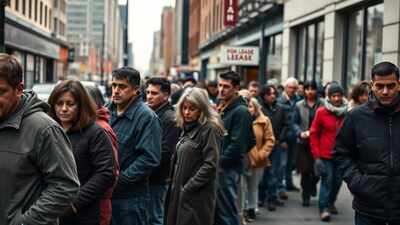ARTICLE AD BOX

Employment data for August revealed significant weakening in US job market conditions, with unemployment climbing to 4.3%, marking a nearly four-year peak. This development strengthens expectations for a Federal Reserve interest rate reduction this month, according to Reuters.The Friday employment report further disclosed June's first job losses in four and a half years, raising concerns about economic stagnation. Job creation has declined since April, with analysts attributing this to governmental policies, including import tariffs, stricter immigration controls, and substantial public sector redundancies."The economy is skating as close to the edge of recession as you can get," said Christopher Rupkey, chief economist at FWDBONDS.
"Companies are clearly hunkering down and refusing to hire and the blame can be traced back to Washington's economic agenda. The only medicine to help is a rate cut from the Fed," he added, quoted by Reuters.August recorded only 22,000 new nonfarm positions, following July's revised increase of 79,000, according to the Bureau of Labor Statistics.Data revisions indicated June experienced a 13,000 job decrease, contrary to the previously reported 14,000 increase, marking the first decline since December 2020.
These adjustments validated concerns raised by substantial downward revisions to May and June figures in July's report, leading to the dismissal of BLS Commissioner Erika McEntarfer. The president alleged data manipulation without providing evidence.Analysts attribute these revisions to the BLS "birth-and-death" calculation method, which estimates employment changes from business openings and closures.The president maintained his criticism of Federal Reserve Chair Jerome Powell regarding interest rates, though avoiding direct comments on the employment figures."Jerome 'Too Late' Powell should have lowered rates long ago. As usual, he's 'Too Late!'" the president had posted on Truth Social.The situation reflects broader economic uncertainties, with import duties raising average tariff rates to levels unseen since 1934, whilst recent court rulings questioning their legality have created additional business uncertainty.Notably, August’s initial payroll numbers may be revised higher, as seasonal factors often cause a weak bias in the first estimate. Nonetheless, employment growth has slowed considerably, averaging 29,000 jobs per month over the last three months, compared with 82,000 in the same period in 2024. The Bureau of Labor Statistics (BLS) is expected to publish preliminary revisions to employment levels for the 12 months through March, which could reinforce the trend of slower job growth.Based on the Quarterly Census of Employment and Wages (QCEW) data, economists estimate employment could be revised down by as much as 800,000. The QCEW draws from employer reports to state unemployment insurance programs.Healthcare added the most jobs in August, with payrolls rising by 31,000, though this was below the 12-month average of 42,000. Social assistance jobs grew by 16,000, while federal government payrolls fell by 15,000, bringing total federal employment down 97,000 since January amid spending cuts.
More declines are expected in October when employees on severance pay drop off the rolls.Manufacturing lost jobs for the fourth consecutive month, highlighting the impact of tariffs. Other sectors—including wholesale trade, information, financial activities, construction, and professional and business services—also shed positions.Wages remain a bright spot, supporting economic expansion for now. Average hourly earnings rose 0.3% in August, matching July, while annual wage growth slowed slightly to 3.7% from 3.9%.
However, declining hours worked raise concerns about overall economic growth.“Today’s news probably raises more questions about the growth outlook than about the Fed outlook,” said Michael Feroli, chief economist at J.P. Morgan. “Private hours worked appear to be contracting at about a 0.5% annual rate this quarter. We remain cautious about growth prospects next quarter.”Financial markets are pricing in a quarter-percentage-point rate cut at the Fed’s September 16-17 meeting, with two more expected before the end of 2025.
The central bank has maintained its benchmark overnight interest rate at 4.25%-4.50% since December. Stocks traded lower on Wall Street, the dollar weakened against a basket of currencies, and U.S. Treasury yields fell.The unemployment rate edged up from 4.2% in July to 4.3%, the highest since October 2021. The household survey indicated 436,000 people entered the labor force, but only 288,000 found employment.
Economists noted that the termination of temporary legal status for hundreds of thousands of immigrants and longer bouts of unemployment contributed to weaker labor force outcomes.The average duration of joblessness increased to 24.5 weeks, the longest since April 2022. “The labor market has hit stall speed,” said Nicole Cervi, economist at Wells Fargo, highlighting the slowdown and persistent challenges in job growth.



.png)
.png)
.png)
















 2 hours ago
3
2 hours ago
3







 English (US) ·
English (US) ·